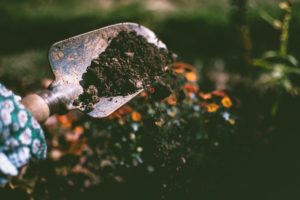Creating Your Dream Sustainable Garden
 Between the pandemic promoting new home hobbies and society’s desire to live more sustainably, home gardens have become extremely popular in recent years. Not only do they give you more control over your food, but they’re good for the environment, and can even boost the value of your home.
Between the pandemic promoting new home hobbies and society’s desire to live more sustainably, home gardens have become extremely popular in recent years. Not only do they give you more control over your food, but they’re good for the environment, and can even boost the value of your home.
Simply put, having a sustainable garden is a win-win. But, how can you create your dream garden and make sure it’s eco-friendly?
Good news – you don’t necessarily have to have a green thumb to make it work. With a little education, time, and trial and error, you can create your dream sustainable garden, grow your own produce, and even give the surrounding wildlife a boost. Let’s look at a few tips that can help you cultivate the garden of your dreams.
Choose Native Plants
One of the best (and easiest) ways to create a successful sustainable garden is to choose plants that will thrive in your environment. Native plants require less water and tend to be able to handle whatever weather conditions are common in your area. Some of the biggest benefits of native plants include:
- They attract pollinators
- They are low maintenance
- They produce beautiful flowers
They can also serve as food and shelter sources for local wildlife, but we’ll talk more about that later.
Adding more plants to your yard isn’t just a great way to boost curb appeal. It promotes sustainability throughout your home and is one of the best upgrades you can make for an eco-friendly property. Nowadays, sustainable upgrades are exceedingly popular, including outdoor improvements like solar panels and rain barrels. You can use those to your advantage when keeping your garden looking lush and full. Solar power can reduce your dependence on nonrenewable resources both inside and outside.
Choose Eco-Friendly Maintenance Habits
Whether you decide to go with native plants, shrubs, herbs, or vegetables, planting your garden is only half the battle. Maintaining it and keeping your plants happy and healthy is where the real work begins.
If you’re already assuming that requires endless watering and countless hours spent in the dirt, it doesn’t have to. There are plenty of garden practices that are sustainable and beginner-friendly. Start with some simple eco-friendly practices, including:
- Composting
- Planting flowers that attract pollinators
- Using natural fertilizing techniques
- Using organic seeds
- Avoiding chemical-based products
Even if you’re able to put one of these habits into practice, you’ll be doing something positive for the planet, and for yourself.
The best part? You don’t necessarily have to wait to start creating a sustainable garden. Depending on your environment, you can get things rolling by creating a greenhouse for your plants. Doing so gives you the opportunity to control lighting, temperature, and watering, so you can create an ideal growing space until your plants are ready to be placed outside. That kind of control means you can rely on things like solar power for lighting and temperature control, and you can reuse water as much as possible to cut back on waste.
Establish an Eco-Friendly Environment
Most people who invest their time in gardens like to be able to sit back and enjoy the beauty that comes from their work. Others, quite literally, want to enjoy the fruits of their labor by harvesting fresh produce and herbs.
Whatever your motivation, your sustainable dream garden should be just as beneficial for local wildlife as it is for you. If you have a pet, you can turn your outdoor space into their own personal paradise by installing a splash pool, giving them a sand pit to dig in, and making sure you’re using pet-friendly plants and fertilizers.
Even if you don’t have a four-legged friend, it’s important to be mindful of local wildlife. The last thing you want is for your garden to disrupt any natural ecosystems. Get to know native wildlife and determine the type of creatures you want to attract – as well as those you want to keep away. For example, deer and rabbits can be pretty to look at, but they could end up eating all of your plants quickly. Bears could enter your yard in search of food, and skunks could end up spraying you or your pet.
Things like putting a privacy fence up, keeping your yard clean and tidy, and making sure you’re not leaving water around outside can help to prevent these creatures and critters from coming into your yard and destroying your garden.
Other animals, like bees and other pollinators, spiders, and other insects could actually help your garden. Creating a safe and healthy place for them will help to improve the planet and help your plants to flourish.
Whether you’re starting a garden for the first time or you want your current one to be more eco-friendly, it’s easier than you might think to put sustainable practices in place. Don’t be afraid to get your hands dirty, and do something good for the planet.


Sorry, the comment form is closed at this time.